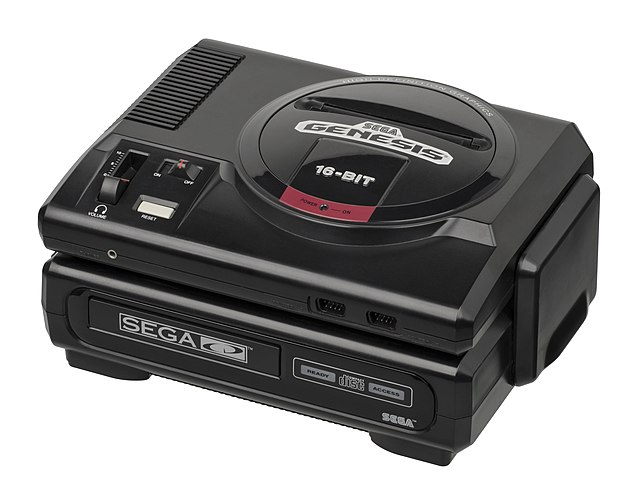The Sega CD, known as Mega-CD in most regions outside North America and Brazil, is a CD-ROM accessory for the Sega Genesis produced by Sega as part of the fourth generation of video game consoles. It was released on December 12, 1991, in Japan, October 15, 1992, in North America, and April 2, 1993, in Europe. The Sega CD plays CD games and adds hardware functionality such as a faster CPU and graphic enhancements such as sprite scaling and rotation. It can also play audio CDs and CD+G discs.
Image: Sega CD Model 1 Set
Image: Sega CD Model 2 Set
A model 1 Sega CD without a Genesis attached. The steel joining plate was included to act as RF shielding between the CD and console hardware.
The motherboard and CD laser assembly to a model 2 Sega CD
The Sega Genesis, also known as the Mega Drive outside North America, is a 16-bit fourth generation home video game console developed and sold by Sega. It was Sega's third console and the successor to the Master System. Sega released it in 1988 in Japan as the Mega Drive, and in 1989 in North America as the Genesis. In 1990, it was distributed as the Mega Drive by Virgin Mastertronic in Europe, Ozisoft in Australasia, and Tectoy in Brazil. In South Korea, it was distributed by Samsung Electronics as the Super Gam*Boy and later the Super Aladdin Boy.
Image: Sega Mega Drive JP Mk 1 Console Set
Image: Sega Genesis Mk 2 6button
The European PAL version of the Mega Drive launched in 1990, later becoming the highest-selling fourth-gen console in Europe.
An edition of the original model of the Genesis, known as the Genesis III, was the model at the center of Sega v. Accolade for its incorporation of the Trademark Security System (TMSS).








